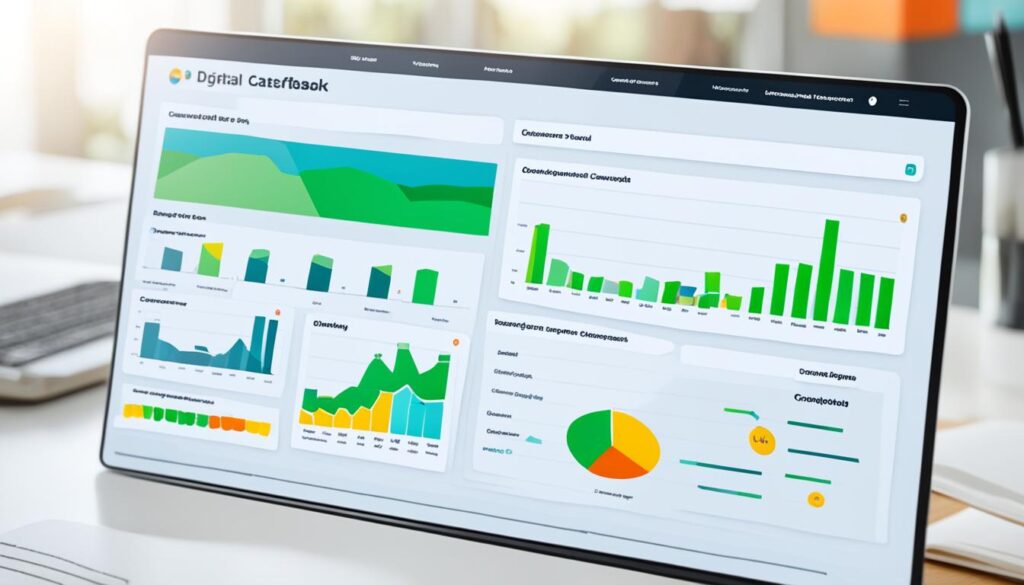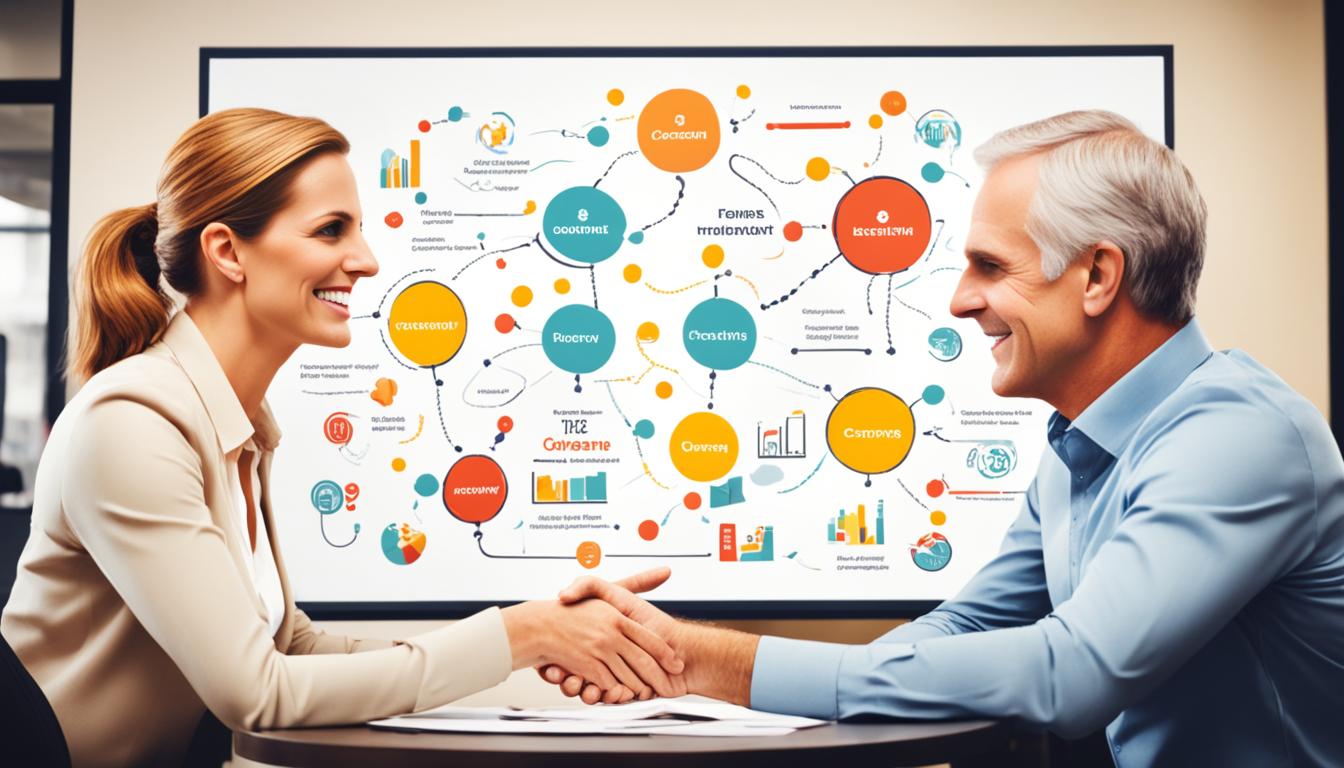Have you ever thought about why some businesses do well even with negative reviews? The secret is in how they work with customers and talk to them. In today’s world, bad reviews can really hurt a company’s image. But, what if we told you that these reviews could actually help you grow and make customers happier?
When customers don’t feel valued, 68% of them leave a company. This shows how important it is to talk to them in a way that shows you care and understand them1. By being positive when you talk to customers, you can make them 28% happier and improve their experience1.
Talking and working with unhappy customers can change a bad experience into a good one. When customers feel listened to and understood, there’s a 70% drop in complaints or negative feedback1. This shows how key it is to really listen and feel what the customer is going through.
Fixing customer problems quickly and well is very important. A huge 82% of customers want a fast fix and clear steps when they complain1. This fact highlights the need for strong plans to handle customer issues and give quick solutions.
Key Takeaways
- Personalized interactions reduce customer churn
- Positive language boosts customer satisfaction
- Active listening decreases negative feedback
- Prompt resolutions are crucial for customer retention
- Effective collaboration turns negative reviews into opportunities
Understanding the Importance of Customer Collaboration
Customer collaboration is key for business growth and making products better. It means working closely with customers to solve problems and improve things for everyone. By listening to customers, companies can build stronger bonds and get valuable insights for ongoing improvement.
Working together with customers has a big impact on success. Companies that team up with suppliers often grow faster, spend less, and make more money than others2. This teamwork helps businesses tap into new skills, cut down on mistakes, get products out on time, and keep up with what customers want2.
Listening to what customers say is crucial for a great customer experience. By working together, companies can make products that really meet customer needs and keep customers coming back2. This way, companies avoid last-minute changes, directly meet customer needs, and hit their goals2.
For businesses to work well with customers, they need to get past some hurdles. These include talking in real time, getting to the right data, setting clear expectations, and dealing with tech issues2. Luckily, there are tools and platforms that make it easier. CRM software is key for keeping track of and understanding customer interactions, which helps with working together better3.
Working well with clients can make them more engaged and loyal4.
Customer collaboration does more than just improve products. It saves time, cuts costs, and makes clients stick around4. In fact, 86% of leaders say not working together enough is the main reason for work problems, showing how crucial it is for keeping good client relationships4.
| Benefit | Impact |
|---|---|
| Time Savings | Streamlined processes and faster issue resolution |
| Cost Reduction | Fewer errors and optimized resource allocation |
| Client Loyalty | Increased engagement and long-term partnerships |
By focusing on working with customers, businesses can make experiences that feel more personal and rewarding. This leads to customers sticking around longer and helps businesses grow in a lasting way.
Active Listening: The Foundation of Customer Collaboration
Active listening is key to working well with customers. It means really focusing on what the customer says, understanding their problems, and answering thoughtfully. This skill helps us find out why customers are unhappy and fix those issues5.

Active listening is very important in customer support. It solves problems, builds trust, and keeps customers coming back. By listening well, we get great ideas for making things better from our customers5.
Let’s look at what makes active listening work:
- Paying full attention
- Showing you understand and care
- Asking questions that open up more talk
- Sharing back what you’ve heard
About 65% of what we say to each other isn’t words. This shows how important it is to notice nonverbal signs when talking to customers. Looking in someone’s eyes 50% to 70% of the time shows you’re really listening6.
Feeling what others feel is a big part of active listening. It helps us get what customers are going through, what hurts them, and what they hope for. When we show we care through how we talk and act, customers feel heard and valued7.
Customers who feel heard are more likely to stay with a brand. This makes relationships stronger and less likely for them to look elsewhere.
To get better at listening, we can try being mindful, work on understanding others better, and practice listening more. These steps help us connect better with customers, understand their issues, and offer solutions that fit just right57.
| Active Listening Technique | Benefits |
|---|---|
| Maintaining eye contact | Signals engagement and attentiveness |
| Using open-ended questions | Encourages thoughtful, expansive responses |
| Reflecting and paraphrasing | Validates thoughts and emotions, ensures understanding |
| Being patient and avoiding interruptions | Allows complete expression of thoughts |
| Remaining non-judgmental | Creates a safe space for open communication |
By getting good at these listening skills, we can make our customer support much better. This leads to stronger relationships, more loyal customers, and more money for our business56.
Collaborating with Unsatisfied Customers: Key Strategies
When dealing with unhappy customers, working together is key. It’s important to know that 80% of customers might leave because of poor service8. We need to fix problems fast to keep them.
Start by saying “thank you” to change their mood8. This simple step can make the conversation go better. It opens the door for talking about solutions.

Listen to what the customer says. Only 1 in 25 customers will tell you about their problems9. This is a chance to make things right and get better.
Own up to the problem and be clear about how you’ll fix it. Work with the customer to find solutions. This teamwork can rebuild trust and turn a bad experience into a good one.
“The customer’s perception is your reality.” – Kate Zabriskie
Remember, many customer service workers face rudeness often10. Stay calm and focus on solving the issue, not getting upset.
| Strategy | Purpose | Impact |
|---|---|---|
| Express gratitude | Set positive tone | Encourages cooperation |
| Active listening | Understand concerns | Identifies root issues |
| Take responsibility | Show accountability | Builds customer trust |
| Collaborative problem-solving | Find mutually beneficial solutions | Increases customer satisfaction |
Using these strategies can turn negative experiences into chances to strengthen our relationships and improve our service. Remember, working together is crucial for solving conflicts and keeping customers.
Effective Communication Techniques for Resolving Issues
When dealing with customer concerns, effective communication is key. We use positive language and a calm tone to focus on the customer. This approach helps turn tough situations into chances to improve customer experience and keep them coming back11.

We make sure to reassure customers, say sorry sincerely, and listen well. We ask good questions, stay positive, and make sure we get what they’re saying11. This method really works, with 85% of customers feeling better when we show empathy12.
It’s important to set clear expectations to avoid misunderstandings. Our team uses neutral language and open body language to solve conflicts. Talking calmly and using “I” statements helps manage disagreements13.
“Our goal is to create solutions that satisfy both our customers and our company.”
We’ve found a warm transfer system works well when moving customers to other departments. Customers like this, with 89% approving12. We also make sure 73% of our customers feel important by telling them their feedback goes to the right teams12.
| Communication Technique | Customer Appreciation Rate |
|---|---|
| Warm transfers | 89% |
| Feedback forwarding assurance | 73% |
| Active empathy | 85% |
| Clear boundary setting | 67% |
We value personal differences and understand they can cause disagreements. This helps us solve conflicts better13. Our dedication to learning helps our team deal with angry customers well, with 81% seeing the benefits12.
Leveraging Technology to Enhance Customer Collaboration
In today’s digital world, technology is key to better customer collaboration. CRM software and data analytics help businesses give personalized support and spot trends in customer feedback. With AI-powered solutions, companies can automate tasks, meeting customer needs faster14.

Omnichannel support makes communication smooth across different platforms, leading to faster replies. AI helps give customers unique experiences by analyzing data. This shows trends and where to improve14. Automation saves time, money, and resources by doing tasks like sending emails and updating records automatically15.
Tools like AI-powered kiosks gather real-time feedback from customers. This data helps professionals quickly solve issues, making customers happier14. Self-help options like FAQs and tutorials let customers solve problems on their own. This cuts down on work and costs for companies15.
AI brings many advantages, but the human touch is still vital for caring customer experiences. A mix of human and AI skills creates a new level of customer satisfaction, increasing loyalty and engagement14. Using technology for custom messages and offers makes interactions more relevant and engaging. This changes how customers work together with businesses.
Conclusion: Transforming Negative Experiences into Positive Outcomes
We’ve looked at how working with unhappy customers can lead to positive results. By focusing on making customers happy and putting them first, businesses can do better financially. Studies show that happy customers are much less likely to leave compared to unhappy ones, showing how key it is to solve problems well16.
Putting effort into customer service is not just a good idea; it’s a wise business choice. By 2024, customer experience will be more important than price and product in making a brand stand out17. A company in HR management saw a 40% increase in productivity and more market share by focusing on customer experience and setting clear goals16.
Improving how we handle customer service leads to more loyalty and success over time. By listening well, showing empathy, and using technology, we can turn negative feedback into chances for growth. Let’s aim to build a culture where every interaction helps make the customer’s experience better and boosts business value.
FAQ
Why is customer collaboration important for businesses?
How can businesses effectively practice active listening when collaborating with customers?
What are some key strategies for collaborating with unsatisfied customers?
How can effective communication techniques help resolve issues with unsatisfied customers?
How can technology enhance customer collaboration?
Source Links
- 17 ways to deal with angry customers: Templates and examples – https://www.zendesk.com/blog/the-best-templates-for-dealing-with-angry-customers/
- The Link Between Supplier Collaboration & Customer Satisfaction – https://www.anark.com/resources/blog/supplier-collaboration-customer-satisfaction
- Customer collaboration: what it is & why you should do it – https://www.ringcentral.com/us/en/blog/customer-collaboration/
- Client Collaboration: Strategies for Sharing Knowledge – https://blog.collabwriting.com/client-collaboration-easy-ways-to-make-it-happen/
- How to Improve Your Active Listening Skills as a Chief Customer Officer – https://advisorycloud.com/blog/how-to-improve-your-active-listening-skills-as-a-chief-customer-officer
- 7 Active Listening Techniques to Practice in Your Daily Conversations – https://www.verywellmind.com/what-is-active-listening-3024343
- How does empathy help you listen actively and build customer loyalty? – https://www.linkedin.com/advice/1/how-does-empathy-help-you-listen-actively-build-s4enc
- How to Deal With Difficult Customers – https://www.businessnewsdaily.com/2864-customer-service-tips.html
- 10 ways to make angry customers happy – https://www.edesk.com/blog/10-steps-turning-angry-customer-happy-one/
- Dealing with Rude Customers: Guide & Proven Strategies – https://missiveapp.com/blog/dealing-with-rude-customers
- 25 Conflict Resolution Strategies for Call Centers | CallMiner – https://callminer.com/blog/25-conflict-resolution-strategies-for-customer-service
- Communicating With the Angry Customer: 10 Quick Tips | Agent Connect – https://www.medallia.com/blog/communicating-with-the-angry-customer-15-quick-tips/
- Communication Tips for Conflict Resolution in the Workplace – https://www.businessnewsdaily.com/8766-resolving-workplace-conflicts.html
- Harnessing the Power of Customer Service by Leveraging Both Humans and AI Solutions – https://hospitalitytech.com/harnessing-power-customer-service-leveraging-both-humans-and-ai-solutions
- How can technology improve your customer service? – https://www.linkedin.com/advice/0/how-can-technology-improve-your-customer
- Avoiding the seven deadly sins of customer-experience transformations – https://www.mckinsey.com/capabilities/operations/our-insights/avoiding-the-seven-deadly-sins-of-customer-experience-transformations
- 15 Examples of Bad Customer Service & Ways to Fix Them – https://www.revechat.com/blog/bad-customer-service/

